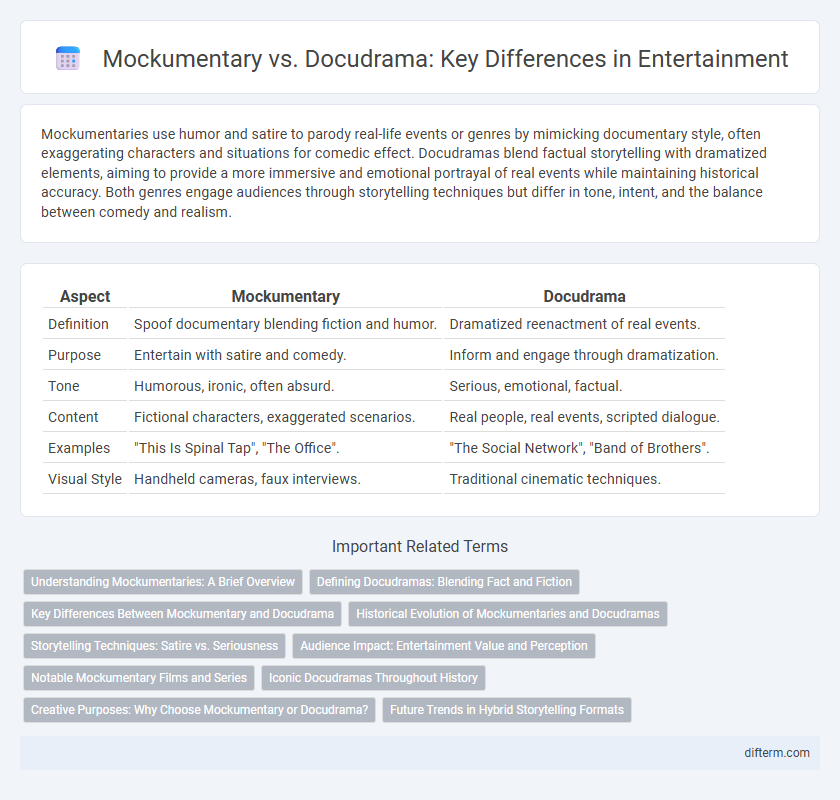Mockumentaries use humor and satire to parody real-life events or genres by mimicking documentary style, often exaggerating characters and situations for comedic effect. Docudramas blend factual storytelling with dramatized elements, aiming to provide a more immersive and emotional portrayal of real events while maintaining historical accuracy. Both genres engage audiences through storytelling techniques but differ in tone, intent, and the balance between comedy and realism.
Table of Comparison
| Aspect | Mockumentary | Docudrama |
|---|---|---|
| Definition | Spoof documentary blending fiction and humor. | Dramatized reenactment of real events. |
| Purpose | Entertain with satire and comedy. | Inform and engage through dramatization. |
| Tone | Humorous, ironic, often absurd. | Serious, emotional, factual. |
| Content | Fictional characters, exaggerated scenarios. | Real people, real events, scripted dialogue. |
| Examples | "This Is Spinal Tap", "The Office". | "The Social Network", "Band of Brothers". |
| Visual Style | Handheld cameras, faux interviews. | Traditional cinematic techniques. |
Understanding Mockumentaries: A Brief Overview
Mockumentaries blend fictional storytelling with documentary-style presentation, using humor and satire to parody real events or social phenomena. Key elements include scripted scenarios, exaggerated characters, and improvised dialogue that mimic authentic documentary techniques. This genre contrasts with docudramas, which dramatize true stories with factual accuracy and emotional depth.
Defining Docudramas: Blending Fact and Fiction
Docudramas blend factual events with dramatized storytelling, portraying real-life incidents through scripted scenes and character interpretations to enhance emotional engagement. They maintain historical accuracy while incorporating creative liberties to fill gaps in the narrative, often featuring actors reenacting documented events. This hybrid format allows viewers to explore true stories with the intensity and structure of a fictional drama, distinguishing docudramas from purely factual documentaries or satirical mockumentaries.
Key Differences Between Mockumentary and Docudrama
Mockumentaries use satire and parody to humorously mimic documentary style, often featuring fictional events and characters, while docudramas dramatize real-life events with scripted dialogue and actors to convey factual stories. Mockumentaries blur the line between fiction and reality through comedic exaggeration, whereas docudramas prioritize historical accuracy and emotional authenticity. The primary distinction lies in mockumentaries' emphasis on entertainment and irony, contrasting with docudramas' commitment to educating audiences through true narratives.
Historical Evolution of Mockumentaries and Docudramas
Mockumentaries evolved from satirical shorts in the early 20th century, gaining prominence with films like "This Is Spinal Tap" (1984) that blend fictional narratives with documentary style. Docudramas have roots in radio dramas of the 1930s, transitioning to television and film with productions such as "The Missiles of October" (1974) that dramatize real historical events. Both genres reflect shifting audience preferences for authentic storytelling, balancing factual representation with creative dramatization throughout entertainment history.
Storytelling Techniques: Satire vs. Seriousness
Mockumentaries employ satire and humor to fictionalize real-life scenarios, exaggerating characters and events for comedic effect, often blurring the line between reality and fiction. Docudramas emphasize seriousness and accuracy, reconstructing actual events with dramatic storytelling to evoke emotional responses and provide deeper insights. The storytelling techniques in mockumentaries rely on irony and parody, while docudramas prioritize authenticity and factual representation.
Audience Impact: Entertainment Value and Perception
Mockumentaries use satire and humor to engage audiences, creating an entertaining experience by parodying real-life events, which often leads viewers to question reality and fiction. Docudramas blend factual storytelling with dramatized scenes to evoke emotional responses and deepen understanding, enhancing audience perception of historical or true events. Both formats influence viewer engagement differently: mockumentaries prioritize entertainment and irony, while docudramas emphasize emotional impact and informative value.
Notable Mockumentary Films and Series
Mockumentary films and series blur the line between fiction and reality by presenting fictional events in a documentary style, with notable examples including "This Is Spinal Tap," "Best in Show," and the acclaimed series "The Office." Unlike docudramas that dramatize real historical events, mockumentaries use satire and irony to critique social norms and media conventions. These productions leverage humor and improvisation to engage audiences while providing unique commentary on contemporary culture.
Iconic Docudramas Throughout History
Iconic docudramas like "Schindler's List" and "The Social Network" blend factual events with dramatic storytelling to create compelling narratives rooted in real history. These films emphasize emotional depth and character development while maintaining historical accuracy, distinguishing them from mockumentaries that use satire and humor to mimic documentary style. The enduring appeal of docudramas lies in their ability to educate audiences about significant events through engaging, dramatized portrayals.
Creative Purposes: Why Choose Mockumentary or Docudrama?
Mockumentaries use satire and humor to critique or parody real-life events, offering creative freedom to exaggerate characters and scenarios for entertainment. Docudramas blend factual storytelling with dramatic elements to engage viewers emotionally while preserving historical accuracy. Choosing between the two depends on whether the goal is to entertain through comedy or to inform while dramatizing real occurrences.
Future Trends in Hybrid Storytelling Formats
Emerging trends in entertainment reveal a growing fusion of mockumentary and docudrama elements, creating hybrid storytelling formats that blur the lines between fiction and reality. Advances in virtual reality and interactive media are enabling immersive narratives where audiences engage directly with characters and plot development. This evolution promises richer, multi-dimensional experiences that redefine traditional documentary and scripted drama conventions.
Mockumentary vs docudrama Infographic

 difterm.com
difterm.com